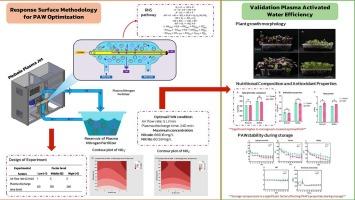Optimization of pinhole plasma jet for reactive nitrogen species generation in Plasma-Activated water and its application in microgreen cultivation
IF 5.9
3区 工程技术
Q1 CHEMISTRY, MULTIDISCIPLINARY
Journal of Industrial and Engineering Chemistry
Pub Date : 2025-07-09
DOI:10.1016/j.jiec.2025.07.018
引用次数: 0
Abstract
PAW is considered a novel replacement of nitrogen fertilizers for sustainable agriculture. The process optimization for a pinhole plasma jet system (i.e., air flow rate and discharge time) to produce PAW with high reactive nitrogen species content and its application in microgreen production was investigated using response surface methodology. According to optimal conditions (i.e., an air flow rate of 5.0 L/min and a discharge time of 240 min), the highest NO3– (668.16 mg/L) and NO2– (60.59 mg/L) were obtained. Broccoli and radish microgreens treated with optimized PAW show higher growth attributes, such as germination percentage and fresh weight, compared to the control treatment. Additionally, the total protein content of both microgreens was significantly increased under optimal PAW, whereas no significant effects were exhibited in total phenolic compounds and antioxidant capacity. The stability of properties of the optimized PAW over 30 days of storage was determined, which is critical for preserving its effectiveness. This study confirms the ability of pinhole plasma jet technology to produce PAW with improved RNS components, as well as the efficacy of PAW in microgreen growing, taking a step towards its broader use in sustainable agriculture.

等离子体活化水中针孔等离子体射流生成活性氮的优化及其在微绿栽培中的应用
PAW被认为是可持续农业中氮肥的新替代品。采用响应面法研究了针孔等离子体喷射系统生产高活性氮组分PAW的工艺优化(即气流流速和放电时间)及其在微绿生产中的应用。在空气流量为5.0 L/min、排气时间为240 min的最佳条件下,NO3 - (668.16 mg/L)和NO2 - (60.59 mg/L)最高。与对照处理相比,经优化的PAW处理的花椰菜和萝卜微蔬菜的发芽率和鲜重等生长性状均有所提高。此外,在最佳PAW处理下,两种微蔬菜的总蛋白含量均显著提高,而总酚类化合物和抗氧化能力无显著影响。确定了优化后的PAW在30天内性能的稳定性,这是保持其有效性的关键。本研究证实了利用针孔等离子射流技术生产具有改良RNS组分的PAW的能力,以及PAW在微绿生长中的功效,为其在可持续农业中的广泛应用迈出了一步。
本文章由计算机程序翻译,如有差异,请以英文原文为准。
求助全文
约1分钟内获得全文
求助全文
来源期刊
CiteScore
10.40
自引率
6.60%
发文量
639
审稿时长
29 days
期刊介绍:
Journal of Industrial and Engineering Chemistry is published monthly in English by the Korean Society of Industrial and Engineering Chemistry. JIEC brings together multidisciplinary interests in one journal and is to disseminate information on all aspects of research and development in industrial and engineering chemistry. Contributions in the form of research articles, short communications, notes and reviews are considered for publication. The editors welcome original contributions that have not been and are not to be published elsewhere. Instruction to authors and a manuscript submissions form are printed at the end of each issue. Bulk reprints of individual articles can be ordered. This publication is partially supported by Korea Research Foundation and the Korean Federation of Science and Technology Societies.

 求助内容:
求助内容: 应助结果提醒方式:
应助结果提醒方式:


